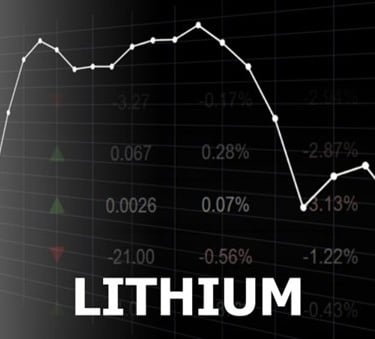Global Lithium Market in 2024: Price Volatility, Supply Adjustments, and Future Trends
Xuan-Ce Wang
12/18/20246 min read


Abstract
The global lithium market faced significant turbulence in 2024, characterized by dramatic price declines and an enduring oversupply issue. These challenges prompted major producers to implement production cuts and reevaluate capital expenditures. Despite these efforts, global lithium supply continued its upward trajectory, delaying market recovery. This report investigates the causes of the persistent oversupply, examining regional production trends, market fragmentation, and supply chain integration. Additionally, it explores the potential impacts of battery industry demand fluctuations and broader economic factors on the market's future. Concluding with insights from industry forecasts, the report highlights the uncertainties surrounding long-term market balance and the timeline for recovery.
1. Lithium Market Price Volatility and Current Supply Adjustments
The global lithium market in 2024 experienced unprecedented price fluctuations, with a steep decline in lithium prices significantly impacting the industry. This price collapse forced producers to adopt drastic measures to mitigate losses and address oversupply.
Price Collapse Triggers Production Cuts:
China and Australia: Lithium miners in these regions responded swiftly to curtail losses by implementing targeted strategies to mitigate the impact of price declines and oversupply challenges:
l Mineral Resources: This Australian mining company ceased operations at the Bald Hill lithium mine, citing economic non-viability under prevailing market conditions. The shutdown also reflected efforts to conserve financial resources and reallocate focus on higher-margin projects.
l Liontown Resources: Facing a constrained market environment, the company scaled back its Kathleen Valley lithium project, delaying capacity expansion plans to avoid exacerbating the oversupply issue while preserving long-term project viability.
l Pilbara Minerals: The company opted to suspend operations at its Western Australia lithium processing plant. This decision was aimed at reducing inventory build-up and limiting unnecessary expenditure in response to weakened global demand.
These measures underscore the proactive stance of lithium producers in China and Australia to stabilize operations amid adverse market conditions, while also laying groundwork for future recovery efforts.
Mineral Resources: Ceased operations at the Bald Hill lithium mine in Australia.
Liontown Resources: Reduced output from its Kathleen Valley lithium project.
Pilbara Minerals: Suspended activities at its Western Australia lithium processing plant.
Global Impact on Industry Leaders: Albemarle, the world’s largest lithium producer, reported an \$11 billion net loss in Q3 due to sustained low pricing. Consequently, Albemarle announced a 6–7% reduction in its global workforce and significant cuts to 2025 capital expenditures.
2. Analysis of Persistent Oversupply
The enduring lithium oversupply stems from a confluence of regional dynamics, strategic priorities, and market structures, each playing a pivotal role in shaping the market's trajectory:
l African Mine Contributions: While producers in regions like Australia and China scaled back, African lithium mines—especially those in Zimbabwe—continued steady operations. Owned predominantly by Chinese battery manufacturers, these mines prioritized uninterrupted production to maintain a cost advantage and secure resource stability for their downstream operations. Notably, Zimbabwe's mining sector expanded significantly in 2024, supported by investments in technology and infrastructure aimed at boosting extraction efficiency.
l Strategic Priorities in China: China’s government-led push for dominance in the EV sector underpins the supply-demand paradox. This policy framework not only stimulated domestic lithium demand through aggressive EV adoption targets but also fortified supply chain robustness. For instance, state-backed initiatives incentivized lithium procurement and processing to mitigate global market volatility impacts. Additionally, export restrictions on key lithium compounds safeguarded local availability and pricing.
l Market Structural Fragmentation: The global lithium industry remains fragmented, characterized by numerous small to mid-sized enterprises. This diversity, while promoting innovation, also dilutes the market's capacity for synchronized response to demand-supply mismatches. For instance, several junior mining companies entered the market during the 2021-2022 lithium price surge, but their projects now contribute to oversupply due to limited operational flexibility and reliance on external financing.
l Technological Lag in Supply Adjustment: Despite efforts to scale production, the technological and logistical delays inherent in mining projects complicate swift realignment to market conditions. Greenfield projects initiated during the lithium boom have only recently reached production stages, further saturating the market. Coupled with the lag in advanced supply chain integration, this dynamic exacerbates global oversupply conditions.
1) Steady Supply from African Mines:
While Australian and Chinese miners scaled back production and delayed expansion projects, African lithium mines, especially those in Zimbabwe owned by Chinese battery manufacturers, maintained steady output. These companies prioritized securing low-cost lithium to sustain market competitiveness. Zimbabwe's lithium production in 2024 saw substantial growth due to heavy investments by Chinese firms in advanced mining technologies and infrastructure. Additionally, government support in Zimbabwe through mining-friendly policies and tax incentives further bolstered operations. This combination of strategic investments and policy support has allowed African mines to solidify their role as crucial suppliers, mitigating some of the pressures faced by other regions in the lithium market.
2) China’s Unique Market Dynamics:
EV Strategy Driving Demand Growth:
The Chinese government has identified electric vehicles (EVs) as a cornerstone of its sustainable transportation and renewable energy strategy. Through substantial subsidies, favorable policies, and investments in charging infrastructure, China has rapidly scaled domestic EV production, achieving record-high sales in 2024. In tandem, lithium demand surged, supporting a temporary uptick in local lithium prices. Furthermore, major EV manufacturers like BYD and NIO expanded their production lines, directly driving increased demand for lithium-ion batteries. Despite this domestic boost, global market fundamentals remain largely unchanged due to the persistent oversupply, which continues to exert downward pressure on prices internationally. The dichotomy between regional demand growth and global supply excess highlights the complexities of achieving market equilibrium.
3) Supply Chain Integration Limits Adjustments:
Many lithium mines are tightly integrated into downstream supply chains, particularly those serving Chinese battery manufacturers. This deep integration has ensured steady production despite low market prices, complicating supply adjustments.
4) Fragmented Market Structure:
The lithium market’s fragmented nature, characterized by numerous emerging companies focused on lithium projects, hampers the industry’s ability to rapidly respond to supply-demand imbalances. This structural fragmentation prolongs oversupply conditions.
3. Outlook for the Lithium Market
The future of the lithium market will be shaped by demand fluctuations, technological advancements, and macroeconomic conditions.
1) Potential Impact of Battery Industry Demand Fluctuations:
Will Adams, Head of Base Metals Research at Fastmarkets, notes that while oversupply persists, battery sector demand fluctuations could introduce periodic imbalances.
Short-term oscillations between shortages and oversupply are possible.
A critical turning point may occur during a battery industry replenishment phase, potentially driving significant price recoveries and accelerating market rebalancing.
2) Uncertainty in Long-Term Market Balance:
The lithium market’s long-term equilibrium remains uncertain due to several factors:
l Economic Growth: Global economic trends will influence EV adoption and lithium demand.
l Policy Changes: Shifts in government policies on renewable energy and transportation could reshape market dynamics.
l Technological Innovation: Advances in battery technology might alter lithium demand or enable alternative materials.
l Competitive Dynamics: Changes in the competitive landscape among lithium producers could influence production strategies and pricing mechanisms.
Leading international brokers anticipate that the oversupply situation will persist until at least 2027. Whether equilibrium and price stability can be achieved by then remains uncertain.
Conclusion
In 2024, the lithium market grappled with severe price volatility and persistent oversupply. While production cuts and strategic adjustments by key players aimed to address these challenges, structural factors such as continuous supply growth, fragmented market dynamics, and tight supply chain integration have prolonged market imbalances. The market’s future hinges on demand from the battery industry, technological advancements, and macroeconomic conditions. Although the oversupply is expected to persist until 2027, a potential demand-driven recovery and strategic realignments could reshape the market trajectory.
References
1. UBS Group AG. "Global Lithium Market Forecast." 2024.
2. Will Adams. "Battery Metals Outlook." Fastmarkets, 2024.
3. Albemarle Corporation. "Q3 2024 Financial Report." 2024.
4. Mineral Resources. "Bald Hill Mine Closure Announcement." 2024.
5. Liontown Resources. "Kathleen Valley Project Update." 2024.
6. Pilbara Minerals. "Western Australia Lithium Processing Report." 2024.
7. Chinese Government. "Electric Vehicle Industry Strategic Plan." 2024.
8. Fastmarkets. "Lithium Market Price Trends." 2024.














